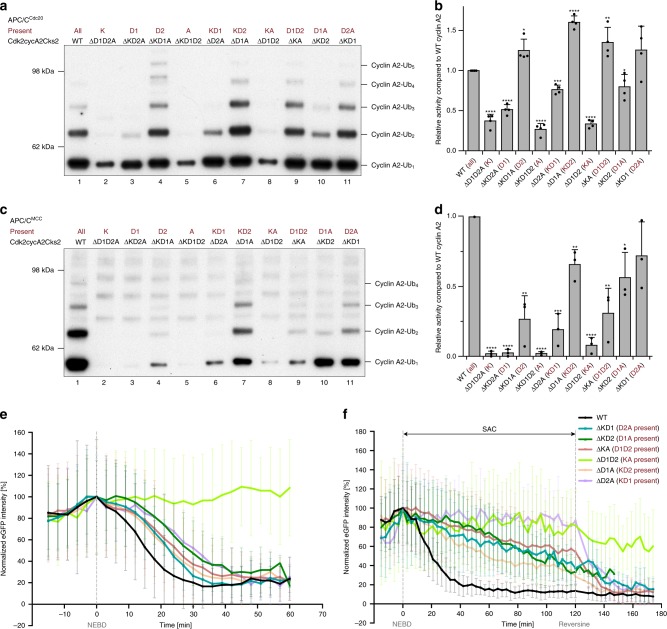Fig. 5.
A cooperation of multiple degrons confers the resistance of cyclin A2 to MCC-imposed inhibition. a–d Ubiquitination assays of double and triple degron mutations in cyclin A2 by APC/CCdc20 (a) and APC/CMCC (c). In all assays, cyclin A2 is in complex with Cdk2-Cks2. The D2 box is the critical determinant for cyclin A2 ubiquitination by APC/CCdc20 (compare lanes 1, 4, 7, 9 and 11 in a). To resist MCC-mediated inhibition, cyclin A2 requires both the KEN box and ABBA motif together with the D2 box (compare lanes 1, 7 and 11 in c). The remaining degrons in cyclin A2 after the mutation are labelled in dark red. Ubiquitination reactions were analysed by western blotting with an anti-His antibody to detect the His-tag of the ubiquitin-modified substrates. Control gels indicating the unmodified substrate for representative reactions are shown in Supplementary Fig. 2. The western-blots were quantified to show the effect of individual mutations, with error bars indicating standard deviation. The APC/C activity towards cyclin A2 mutants is normalized to ubiquitination of wild-type cyclin A2 and significance is calculated using unpaired Student’s t-test (indicated with stars, n = 4 for b and 3 for d, Supplementary Table 2). e, f Degradation profiles of the eGFP-cyclin A2 double degron mutants in HEK cells under unperturbed mitosis (e) and a SAC arrest using STLC (f). The total eGFP fluorescence minus background fluorescence for each cell at each time point was normalized to NEBD, quantified and plotted over time. The timepoints of NEBD and reversine addition to release the SAC arrest are marked, respectively. Error bars indicate mean ± standard deviation of n = 62 wild-type, 33 ΔKD1, 58 ΔKD2, 34 ΔKA, 28 ΔD1D2, 48 ΔD1A and 23 ΔD2A cells under unperturbed mitosis and 13 wild-type, 15 ΔKD1, 12 ΔKD2, 20 ΔKA, 12 ΔD1D2, 19 ΔD1A and 13 ΔD2A cells under a SAC arrest from three experiments. Source data are provided as a Source Data file

